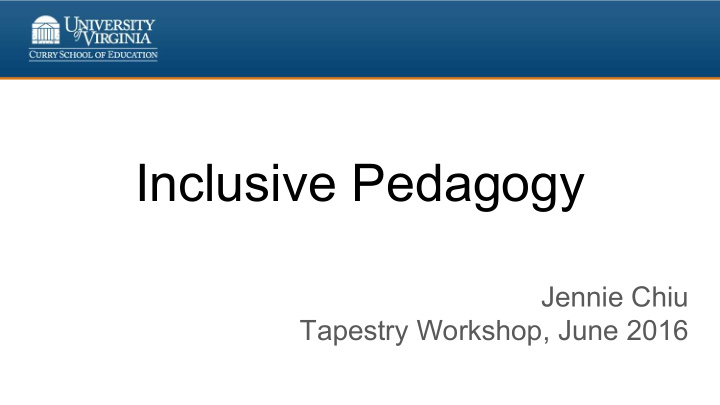



Inclusive Pedagogy Jennie Chiu Tapestry Workshop, June 2016
Overview Review of educational theories Brief discussion of inclusive pedagogies Working jigsaw session on strategies General Discussion
How do you define learning? On a piece of paper/computer, write down how you define learning.
How do you define learning? On a piece of paper/computer, write down how you define learning. Now share your response with 2-3 other people. Try to construct a joint definition that incorporates each person’s definition.
How do you define learning?
Brief review of educational theories Transmission Constructivist Inside the mind Social, cultural ● Contextual ● Active ● Social
Implications of how we learn ● Context ● Social structures/conventions ● Prior knowledge ● Classroom/school climate
Inclusive Pedagogy What is it?
Inclusive Pedagogy Creating a learning environment in which students feel equally valued “ Even though some of us might wish to conceptualize our classrooms as culturally neutral or might choose to ignore the cultural dimensions, students cannot check their sociocultural identities at the door… Therefore, it is important that the pedagogical strategies we employ in the classroom reflect an understanding of social identity development so that we can anticipate the tensions that might occur in the classroom and be proactive about them” (Ambrose et. al ., 2010, p. 169-170).
Inclusive Pedagogy - Guiding Principles Building on students’ prior experiences and School environment knowledge ● Strength, not deficit mindset Class environment Teacher Student Multiple perspectives of content presented Increasing awareness of problematic Tools assumptions
Strategies for Inclusive Teaching - Jigsaw What are some strategies that you already School environment use or know about to foster an inclusive classroom? 5 Class environment 4 Jigsaw: First 5 groups around each area, 1 then one person from each group will 2 Teacher Student present to another group. 3 http:/tinyurl.com/tapestry2016 Tools
Group 1: Teacher-Student Interactions How can teachers interact with students to foster inclusive classrooms? Not using gender specific pronouns, using names Using “get to know you” activities/icebreakers Attending extracurricular activities and expressing interest in student lives Making the classroom a safe and positive environment for all Strategies to ensure equitable classroom participation Teacher accessibility Avoid “planting weeds”- explicit attention to demographics Giving meaningful feedback to students- WISE feedback
Group 2: Student-Student Interactions How can we facilitate student-student interactions to foster inclusive classrooms? ● Grouping exercise that encourage interaction. ○ i.e: Group based on birthday, animal name, etc… ● Creating a classroom culture to accept differences that values teamwork. ● Allowing students to give feedback to other students, a compliment sandwich, one good, one improvement, another good. ● Build relationships early.
Group 3: Teacher-Tools (curriculum, projects, etc.) How can we design projects, homework, curricula, to foster an inclusive classroom?
Group 4: Teacher - Class environment How can a teacher create a class environment to foster an inclusive classroom? ● Pay attention to groupings ● Teach group skills ● Expected and accepted norms of behavior and interaction ● Multiple presentations of information (not multiple intelligences) ● Allow for diverse opinions and backgrounds to “be heard”
Group 5: Teacher-School interactions How can we work with the school culture to foster inclusive classrooms? ● Educating guidance and administrators ● Educating other math/science teachers ● Inter-visitations for teachers/admin to see inclusion in action ● Promote other classes (math) so that those teachers promote your class ● School-wide activities to peak interest of all students ● Exposure to all students (hallway posters - advertising current student successes, field trips, gallery walk) ● Send current students (who are well spoken) to talk to prospective students (at lunch, fairs, other school events, elementary schools) ● Competitions (voting) for all students to get involved and see projects/ideas made in a CS class
Jigsaw! Now share your group’s strategies. After everyone has shared their strategies, think of adding more that are specific to your grade level/contexts.
Group A:
Group B:
Group C:
Group D:
Group E:
Add Questions What questions did this activity raise for you? Add at least one question (or a few) at the end of the slide to be addressed by the class. Link to rest of presentation
Recommend
More recommend